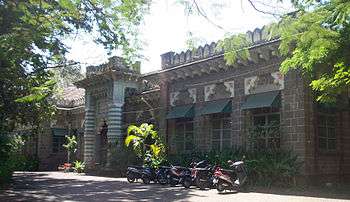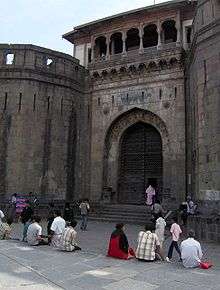Bhandarkar Oriental Research Institute

The Bhandarkar Oriental Research Institute (BORI) is located in Pune, Maharashtra, India.[1] It was founded on July 6, 1917 and named after Dr. Ramakrishna Gopal Bhandarkar (1837–1925), long regarded as the founder of Indology (Orientalism) in India. The institute is well known for its collection of old Sanskrit and Prakrit manuscripts.
The Institute
This institute is of a public trust registered under Act XXI of 1860. Initially, the institute received an annual grant of 3000 Rupees from the Government of Bombay. Presently, it is partially supported by annual grants from the Government of Maharashtra. The Institute also receives grants from the Government of India and the University Grants Commission for specific research projects.
The institute has one of the largest collections of rare books and manuscripts in South Asia, consisting of over 1,25,000 books and 29,510 manuscripts. The institute publishes a journal, Annals of the Bhandarkar Oriental Research Institute four times a year. The Institute also hosts the Manuscripts Resource and Conservation Centre under the auspices of the National Mission for Manuscripts, a project of the Ministry of Culture, Government of India. In 2007, the Rigveda manuscripts preserved at the Institute were included in UNESCO’s Memory of the World Register.[2][3]
The manuscript collection
The Government of Bombay, in 1866, started a pan Indian Manuscript Collection project. Noted scholars like Georg Bühler, F. Kielhorn, Peter Peterson, Ramkrishna Gopal Bhandarkar, S. R. Bhandarkar, Kathavate and Ghate collected more than 17,000 important manuscripts under this project. This collection was first deposited at Elphinstone College in Bombay. Then it was transferred to Deccan College (Pune) for better preservation. After the Bhandarkar Oriental Research Institute was founded in 1917, the BORI founders proposed to offer even better preservation and research. Hence Lord Willingdon, the then Governor of the Bombay Presidency and the first president of BORI, transferred the valuable Government collection of manuscripts to the BORI on April 1, 1918. The first curator, P.K. Gode took active initiatives to enhance this collection. Presently, the Institute has over 29,000 manuscripts.
The largest part of the collection (17,877 Manuscripts) is part of the "Government Manuscript Library", while there is an additional collection of 11,633 manuscripts also. The most prized collections include a paper manuscript of the Cikitsāsārasangraha dated 1320 and a palmleaf manuscript of the Upamitibhavaprapañcakathā dated 906.
Among the several scholars referring to the works at BORI, the most well-known person arguably is the Bharat Ratna awardee, Pt. Pandurang Vaman Kane.
The Critical Edition of the Mahabharata
A long term project under the auspices of BORI, started on April 1, 1919, was the preparation of a Critical Edition of the Mahabharata. V.S. Sukthankar was appointed general editor of the project on August 1, 1925 and he continued until his death on January 21, 1943. After his death, S.K. Belvalkar was appointed general editor on April 1, 1943. On April 1, 1961 P. L. Vaidya appointed as General Editor of the project on the retirement of S. K. Belvalkar. R. N. Dandekar appointed as the joint general editor on July 6, 1957. To widespread acclaim, the completion for publication was announced on September 22, 1966, by Dr. Sarvapalli Radhakrishnan, then President of India, at a special function held at the institute.
The Critical Edition was collated from 1,259 manuscripts.[4] This edition in 19 volumes (more than 15000 demi-quarto size pages) comprised the critically constituted text of the 18 Parvas of the Mahabharata consisting of more than 89000 verses, an elaborate Critical Apparatus and a Prolegomena on the material and methodology (volume I), written by V.S. Sukthankar.
Further work since the initial publication has produced a Critical Edition of the Harivamsa, a Pratika Index, a Bibliography of ancillary materials, and a Cultural Index. The project of preparing a critical edition of the Harivamsa was inaugurated by the President of India, Rajendra Prasad on November 19, 1954. The publication was completed in November, 1971. The critical edition in two volumes consists the 4 Parvans of the Harivamsa. The Pratika Index in 6 volumes consists 360000 verse quarters with appendices. Two volumes of the Cultural Index have been published so far. The constituted text of the critical edition has also been made available on the CD-ROM.
Vandalism in 2004
The institute was vandalized on Monday, 5th January 2004 by a mob made up of members of an extremist self-styled Maratha youth squad, calling themselves the Sambhaji Brigade, named after Shivaji's elder son. They claimed to be angered by the help provided by the institute's staff (in translating manuscripts) to a Western writer, Dr. James Laine, who discussed the telling and retelling of stories about Shivaji's parentage and life in his book on narrations of the Shivaji story.[5] The mob also damaged thousands of manuscripts[6] and attacked Shrikant Bahulkar, a Sanskrit scholar who had only explained some Sanskrit references to Laine.[7] The incident provoked widespread reaction[8] and historian Gajanan Mehendale to destroy parts of his in-progress biography of Shivaji.[9][10]
The vandalism and the subsequent ban on the book were denounced in a statement by historians, among whom were R.S. Sharma, R.C. Thakran, Suraj Bhan, Irfan Habib, D.N. Jha, Shireen Moosvi and K. M. Shrimali.[11] Oxford University Press - publisher of James Laine's, Shivaji: Hindu king in Islamic India, withdrew the book after protests from Ninad Bedekar and other right-wing politicians as it contained allegedly objectionable statements about Shivaji.[12]
References
- ↑ Bhandarkar Institute, Pune
- ↑ "National Mission for Manuscripts". Ministry of Tourism. May 16, 2008.
- ↑ "Rigveda". UNESCO Memory of the World Programme.
- ↑ Bhandarkar Oriental Research Institute Archived February 9, 2008, at the Wayback Machine.
- ↑ 'Maratha' activists vandalise Bhandarkar Institute Times of India - January 6, 2004
- ↑ Mob ransacks Bhandarkar Institute, destroys rare manuscripts, The Hindu
- ↑ "Raj Thackeray apologises to Bahulkar". The Times Of India. December 29, 2003.
- ↑
- ↑ Historian destroys magnum opus
- ↑ Scholar destroys own work on Shivaji
- ↑ "Historians protest ban on book". The Hindu. 2004-01-18. Retrieved 2009-04-05.
- ↑ Damle, Manjiri (2003-12-27). "Scholar destroys own work on Shivaji". The Times of India, Pune. Times News Network. Retrieved 2010-05-17.
